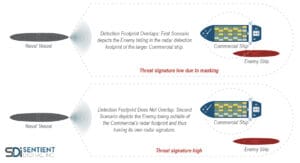In the realm of artificial intelligence, AI systems can be designed to aid their human controllers and provide informed decisions in the blink of an eye. While some may say that such a program may be counterintuitive and that humans need to be the ones considering all factors when making decisions, AI systems can be programmed to consider multiple factors, compare them against a given set of known factors regarding the situation, and inform human controllers of the calculated results in mere moments. This allows for a guard dog AI system that can provide peace of mind as human personnel complete other tasks, wherever they may be. Sentient Digital is currently developing Grey Sentient, a naval Common Operational Picture (COP) that utilizes Bayesian networks to aid human controllers in identifying and targeting enemy vessels in naval shipping lanes.
A probabilistic graphical model such a Bayesian network can take into consideration multiple factors to consider the likelihood of a given event or situation and inform human controllers. As a technology solutions provider, Sentient Digital, Inc. specializes in cybersecurity and tech solutions for both commercial and government clients. Featuring insight from our in-house AI SME Gene Locklear, we will take a look at the dynamic combination of Bayesian networks and artificial intelligence, and how they can be used to protect and monitor naval shipping lanes around the world.
The Importance of Naval Shipping Routes
Naval shipping routes are one of the world’s busiest and most congested areas of travel. With physical constraints, such as coastlines, winds, and marine currents, and political borders shaping these travel routes, shipping vessels are constricted to sharing the same routes as they travel from one port to the other.
Map of World’s Shipping Routes developed by Kiln based on data from the UCL Energy Institute
With so many shipping vessels constantly traveling around the world, it’s no surprise that there are various risks associated outside of natural forces such as hurricanes or ocean currents. Piracy, terrorism, and smuggling pose a significant risk to the safety of naval vessels and their crew. Recent events include the increased threats faced in the Red Sea, with hundreds of cargo ships being rerouted to the southern tip of Africa to avoid attacks from rebel groups.
With around 80% of world trade being transported by sea, it’s vital that such an important asset is protected for commerce and cargo to freely move from one port to another without interference. The U.S. Navy safeguards the world’s shipping lanes from various threats, supporting not just our own economy but all affected shipping lanes that they patrol. These benefits can be seen in other, more specific areas as well. As the South China Sea is quickly turning into a bustling hub of global trade and economic development, even a minor disruption would be felt all around the world. The presence of the U.S. Navy works to stabilize this fast-growing region “…by serving as a floating insurance policy,” as reported in an article by American Enterprise Institute.

Shipping lanes are commonly monitored using radar. Radar enables ships to easily track and manage the number of ships passing through these shipping lanes. One problem that can arise with the usage of radar is a problem commonly referred to as a “pile-up” where a single target on a radar display is in actuality two or more ships passing in close proximity to each other. With cargo ships easily reaching lengths of over 400 meters, it can be easy for small enemy ships to hide in their proverbial shadow, traveling close enough to pass as a single radar blip and slipping by undetected.
U.S. Navy Problems with Threat Analysis in Commercial Shipping Lanes
In the complex operations of naval threat targeting, understanding the difference between enemy ships and neutral ships in busy commercial shipping lanes is of utmost importance to maintain security and ensure the unhindered flow of maritime commerce. Bayesian networks, a type of probabilistic model that utilizes tables to show the likelihood of events happening based on other factors, is a powerful tool for enhancing the decision-making processes in such an uncertain environment. Bayesian networks encapsulate the probabilistic relationships between various observable and hidden factors, such as ship behavior, communication patterns, and known threat profiles, to offer a more structured approach to showcase the likelihood of a ship being a threat. This method allows for the combination of differing sources of information, including real-time radar data and historical navigation patterns, to update the likelihood of a threat as new evidence is obtained.
Understanding Bayesian Networks
To better understand how Bayesian networks work in an AI naval system, let’s go over the basics.
Bayesian networks are a type of probabilistic graphical model that can be used to build a framework from data. They can be used for reasoning, casual modeling, anomaly detection, and more. They are ideal in settings that consider an occurred event and can predict the likelihood which of several possible causes was the contributing factor.
In a common setting that many may be familiar with, a wet lawn can be caused by multiple factors; we’ll consider only two in this example, those being an active sprinkler or rainy weather. In this example, rain has a direct effect on the usage of the sprinkler as that when it does rain, the sprinkler is usually not active. If the grass is wet and the sprinkler is not active, then the most likely cause of the grass becoming wet was rain. Other factors can be added to the model to accurately determine the likelihood of rain causing a wet lawn including surrounding factors (the neighbor’s lawn also being wet), the current time in relation to the sprinkler activation schedule, the weather forecast, and more.

In this instance, a Bayesian network can determine whether a wet lawn was caused by rain or an active sprinkler.
Sentient Digital’s Grey Sentient
At SDi, we are in the development of Grey Sentient, which is a naval Common Operational Picture (COP) system to be employed on all U.S. Navy surface combatants. Grey Sentient has been designed as a sophisticated integration of artificial intelligent systems that use Bayesian networks and Bayesian inference methodologies to enhance maritime security by accurately identifying and targeting enemy ships within commercial shipping lanes. Grey Sentient leverages the power of probabilistic reasoning, complete with goal-oriented intelligent agents, to make anti-ship missile targeting less of a burden on naval radar operators and crews.
At its core, Grey Sentient uses Bayesian Networks to model the correlations between various indicators of threat behavior. These indicators can include unusual navigation patterns, communication anomalies, ship registration discrepancies, and historical data on piracy or terrorist activities that have been commonly associated with certain vessels or areas. By comparing shipping lane tracking data and fleet observations, Grey Sentient calculates the likelihood that any given ship poses a threat, essentially sifting through the ‘noise’ to provide Shoot-No Shoot recommendations.
Grey Sentient: A Probabilistic Targeting Decision System
Grey Sentient’s design incorporates a ‘Target Learning’ system where past outcomes of engagements and interventions add to the system’s learning process, enhancing its accuracy over time. This learning system, combined with the system’s ability to integrate information from diverse sources including satellite imagery and electronic intelligence, makes Grey Sentient highly valuable to the situational awareness of a naval task force.
Operational Architecture of Grey Sentient
The combination of the predictive power of Bayesian networks to analyze complex data and the independent decision-making capabilities of intelligent agents together create a highly dynamic and responsive decision-making system. Grey Sentient’s synergistic system works by:
- Data Analysis and Threat Detection
- Bayesian networks serve as the analytical backbone, processing different inputs such as ship movement patterns, communication data, and historical threat intelligence. By calculating the probability of various scenarios (e.g. whether a specific ship is a threat), these networks can effectively identify potential threats based on their assigned likelihood scores. This assessment is continuously updated with new evidence, allowing for an ever-evolving understanding of the situation. This extends the classic form of the Bayesian network into a dynamic Bayesian network, in which the original model is extended with additional factors that can evolve over time.
- Intelligent Agent Activation
- Once potential threats are identified, intelligent agents of Grey Sentient are employed. These agents are designed to act independently within set parameters, making decisions on how to engage with identified targets. The agents use the probabilistic outputs from the Bayesian networks to prioritize threats and decide on the best course of action, such as closer monitoring, direct engagement, or calling for human intervention.
- Decision Execution
- The intelligent agents suggest an engagement decision, which could range from deploying drones for closer surveillance to initiating contact with the suspected enemy ship for identification purposes. The agents can also recommend escalating the situation based on the evolving threat level and employ defensive measures if necessary. As per current U.S policy, the automated system allows for its human controllers to make the final decision in any situation.
- Cyclic Response for Continuous Learning
- An important aspect of this system is its inherent ability of cyclic response. A cyclic response within programming is a response that occurs inside a closed loop that limits the number of external influences on the outcome. The outcomes of any engagement and its subsequent decisions are fed back into the Bayesian network. This information is used to refine and update the models, which in turn improves their accuracy over time. This continuous learning process ensures that the system continuously adapts to new tactics used by any threat and remains effective in ever-changing circumstances.
Grey Sentient as Future Adaptive Naval Technology
Grey Sentient stands as a major effort by SDi for the usage of probabilistic classification models, combined with artificial intelligence systems, to create a practical solution in protecting maritime commerce against ever-evolving threats. Its development is designed to not only showcase the potential of artificial intelligence and probabilistic modeling in defense strategies but also to enhance the standard for operational efficiency and accuracy in naval threat targeting.
Sentient Digital remains at the forefront of innovation and technological advancement. Beyond our AI-based expertise, we also specialize in software engineering and cybersecurity. Get in touch with a representative today or view our job board to join our team!




